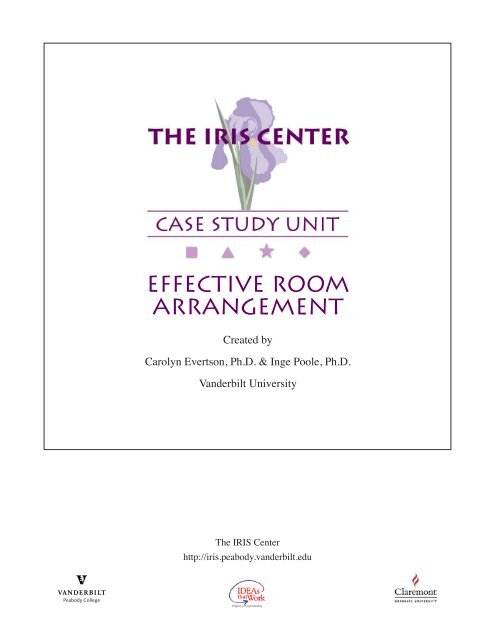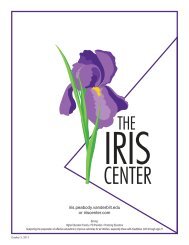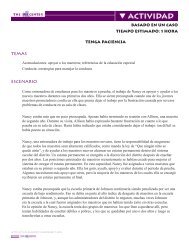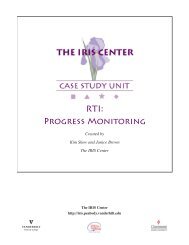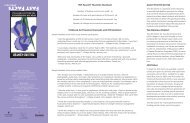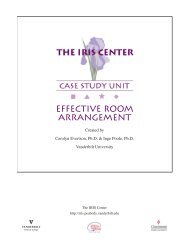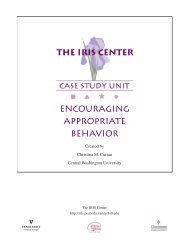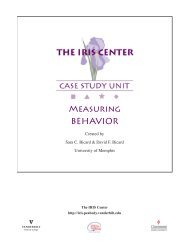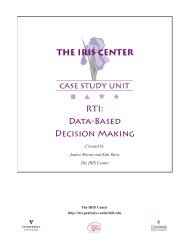Effective Room Arrangement - The IRIS Center - Vanderbilt University
Effective Room Arrangement - The IRIS Center - Vanderbilt University
Effective Room Arrangement - The IRIS Center - Vanderbilt University
You also want an ePaper? Increase the reach of your titles
YUMPU automatically turns print PDFs into web optimized ePapers that Google loves.
EFFECTIVE ROOM<br />
ARRANGEMENT<br />
Created by<br />
Carolyn Evertson, Ph.D. & Inge Poole, Ph.D.<br />
<strong>Vanderbilt</strong> <strong>University</strong><br />
<strong>The</strong> <strong>IRIS</strong> <strong>Center</strong><br />
http://iris.peabody.vanderbilt.edu<br />
Project #H325F060003
Contents: Page<br />
Contents: Page<br />
Case Study Level A, Case 1 ..........................................2<br />
Case Study Level A, Case 1 ..........................................2<br />
Case Study Level A, Case 2 ..........................................3<br />
Case Study Level A, Case 2 ..........................................3<br />
Case Study Level B, Case 1 ..........................................4<br />
Case Study Level B, Case 1<br />
Case Study Level B, Case 2 ..........................................6<br />
Case Study Level B, Case 2 ..........................................6<br />
Case Study Level C, Case 1 ..........................................8<br />
Case Study Level C, Case 1 ..........................................8<br />
STAR Sheet: Minimizing Distractions ................................10<br />
STAR (Strategies and Resources) Sheets ..............................10<br />
STAR Sheet: Maximizing Access ....................................11<br />
STAR Sheet: Matching <strong>Arrangement</strong> with Lesson Purpose .................13<br />
STAR Sheet: Movement with Ease ...................................15<br />
To contact the <strong>IRIS</strong> <strong>Center</strong>:<br />
<strong>IRIS</strong>-Central<br />
<strong>IRIS</strong>-West<br />
Modules and Materials<br />
Development<br />
Naomi C. Tyler, Ph.D.<br />
<strong>Vanderbilt</strong> <strong>University</strong><br />
To cite this case study unit:<br />
Evertson, C., Poole, I., & the <strong>IRIS</strong> <strong>Center</strong>. (2002). <strong>Effective</strong> room arrangement.<br />
Retrieved on [month day, year,] from http://iris.peabody.vanderbilt.edu/case_studies/<br />
ICS-001.pdf<br />
For an Instructor’s Guide to this case study unit, please email your full name, title, and institutional affiliation to the <strong>IRIS</strong> <strong>Center</strong> at<br />
iris@vanderbilt.edu.<br />
<strong>The</strong> contents of this case study were developed under a grant from the U.S. Department of Education, #H325F060003. However,<br />
those contents do not necessarily represent the policy of the U.S. Department of Education, and you should not assume<br />
endorsement by the Federal Government. Project Officer, Shedeh Hajghassemali.<br />
Phone: (615) 343-6006<br />
(800) 831-6134<br />
FAX: (615) 343-5611<br />
EMAIL: iris@vanderbilt.edu<br />
http://iris.peabody.vanderbilt.edu<br />
Technical Assistance<br />
and Training<br />
Deborah D. Smith, Ed.D.<br />
Claremont Graduate <strong>University</strong><br />
Phone: (909) 607-8982<br />
(866) 626-<strong>IRIS</strong> [4747]<br />
FAX: (909) 607-0959<br />
EMAIL: iris@cgu.edu<br />
<strong>IRIS</strong>-East<br />
Partnerships and Consumer Input<br />
Judy Smith-Davis, Ph.D.<br />
Washington, DC<br />
Phone: (703) 239-1557<br />
EMAIL: judysd@cox.net<br />
1
Background<br />
Student: Edward<br />
Age: 8.3<br />
Grade: 3rd<br />
http://iris.peabody.vanderbilt.edu<br />
EFFECTIVE ROOM ARRANGEMENT<br />
LEVEL A • CASE 1<br />
Scenario<br />
Edward is a third grader who seems distracted during independent work time. He is either not finishing<br />
his independent work or else he is completing it haphazardly. Edward’s IEP suggested he be seated<br />
near the chalkboard where the independent work directions are written. However, after sketching the<br />
classroom arrangement (below), his teacher begins to suspect that Edward’s off-task behavior may be a<br />
result of his seating location (starred). His teacher has decided to rearrange the classroom so that Edward<br />
will achieve the following goals within six weeks:<br />
• Increase the quantity of time on-task during independent work<br />
• Increase the number of assignments completed<br />
Possible Strategies<br />
• Minimizing distractions<br />
• Maximizing access<br />
• Matching the arrangement to lesson purpose<br />
! Assignment<br />
• Read the STAR sheets on each of the three possible strategies.<br />
• Given what you’ve learned from the STAR sheets, look back at the scenario. Identify three issues (one<br />
related to each strategy) that may be distracting Edward.<br />
2
Background<br />
Student: Cheri<br />
Age: 7.1<br />
Grade: 1st<br />
http://iris.peabody.vanderbilt.edu<br />
EFFECTIVE ROOM ARRANGEMENT<br />
LEVEL A • CASE 2<br />
Scenario<br />
Cheri is a repeating first grader who missed much of her initial first-grade year due to medical reasons.<br />
She has been diagnosed with a syndrome that is characterized by fragile bones. For Cheri, simple<br />
jostling or bumps can result in broken bones. She walks with leg braces and uses a walker. Cheri is<br />
protectively seated beside the teacher’s desk, separate from the other students. At this location, Cheri has<br />
a place to put her walker for easy access. Her academic work demonstrates that she is progressing with<br />
her peers; however, her social interaction skills are below grade level. With this information in mind,<br />
Cheri’s teacher has decided to reassign Cheri’s seating location to help her achieve the following goals<br />
within nine weeks:<br />
• Increase her positive interactions with peers.<br />
• Increase her safe movement to and from the group table for small group reading instruction and into and<br />
out of the classroom.<br />
Possible Strategies<br />
• Maximizing access<br />
• Movement with ease<br />
! Assignment<br />
• Read the STAR sheets on each possible strategy.<br />
• Select one seating location (A, B, or C) for Cheri. Explain why this location is or is not suitable to help<br />
Cheri meet her goals based on the strategies of maximizing access and movement with ease.<br />
3
Background<br />
Student: Marcus<br />
Age: 7.5<br />
Grade: 2nd<br />
http://iris.peabody.vanderbilt.edu<br />
EFFECTIVE ROOM ARRANGEMENT<br />
LEVEL B • CASE 1<br />
Scenario<br />
Marcus is an active second grader. Whether tapping his pencil, adjusting his seat, sharpening his<br />
pencil, “shooting baskets” with his trash, or walking through the room, Marcus seems to be in constant<br />
motion. During independent work, Marcus’s constant motion is often evidence that he is off-task.<br />
This is particularly the case when his teacher is working with a small group at the group table. <strong>The</strong><br />
teacher interrupts the small group on a regular basis to try to get Marcus refocused on his independent<br />
work. Marcus’s teacher made a sketch (below) of the classroom and recognized that there were several<br />
distractions that might encourage Marcus to be off-task. <strong>The</strong> teacher is planning to rearrange the<br />
classroom and/or Marcus’s seating position (starred) to help him meet the following goals in four weeks:<br />
• Increase the quantity of time on-task during independent work<br />
• Increase the number of independent assignments completed<br />
• Decrease the number of interruptions to the small group instruction<br />
Possible Strategies<br />
• Minimizing distractions<br />
• Maximizing access<br />
• Matching arrangement to lesson purpose<br />
• Movement with ease<br />
4
!Assignment<br />
• Review the STAR sheets on each possible strategy.<br />
• Identify three things to move (items, equipment, individuals) in the classroom sketch above that are<br />
possible distractions for Marcus.<br />
• Explain: 1) what three things you would move in this classroom; 2) why you would move them<br />
(including which strategy or strategies you are using); and 3) how will your three changes to the<br />
classroom help Marcus meet his goals?<br />
http://iris.peabody.vanderbilt.edu<br />
5
Background<br />
Students: Robert Latisha Helen Paulo<br />
Ages: 9.2 9.7 9.5 10.4<br />
Grade: 4th 4th 4th 4th<br />
Scenario<br />
http://iris.peabody.vanderbilt.edu<br />
EFFECTIVE ROOM ARRANGEMENT<br />
LEVEL B • CASE 2<br />
Robert, Latisha, Helen, and Paulo are fourth graders who join their fourth-grade class in the science<br />
lab for science instruction following their special education math class. <strong>The</strong> special education teacher<br />
has requested that the science teacher place these fourth graders at seating locations separate from one<br />
another. This would allow the students to interact with other fourth graders during science. <strong>The</strong> special<br />
education teacher provided the following information to the science teacher to help in assigning seating<br />
locations:<br />
Robert Needs to be near the chalkboard to see written material<br />
or near the demonstration table to see demonstrations.<br />
Is easily distracted by other students.<br />
Likes to volunteer to help the teacher.<br />
Latisha Is shy.<br />
Is easily pulled off-task by distractions, especially<br />
computers.<br />
Does a good job of pretending to be on-task when<br />
she does not understand how to do something or isn’t<br />
interested.<br />
Helen Is talkative.<br />
Will try to monopolize the teacher’s attention.<br />
Is a strong reader.<br />
Paulo Loves science.<br />
Gets along well with other students.<br />
Works well in groups.<br />
Has a crush on Latisha.<br />
Possible Strategies<br />
• Minimizing distractions<br />
• Maximizing access<br />
• Matching arrangement to lesson purpose<br />
• Movement with ease<br />
6
!Assignment<br />
• Review the STAR sheets on each possible strategy.<br />
• Place the four students at a seating location in the classroom arrangement sketch above. For each<br />
student, write the name of the student and the letter of the assigned seat.<br />
• For each student, explain why you selected the specific seating location you did and include which<br />
strategies you used in making your decisions.<br />
http://iris.peabody.vanderbilt.edu<br />
7
Background<br />
Student: Donna<br />
Age: 10.8<br />
Grade: 5th<br />
http://iris.peabody.vanderbilt.edu<br />
EFFECTIVE ROOM ARRANGEMENT<br />
LEVEL C • CASE 1<br />
Scenario<br />
Donna is a fifth grader who has recently increased the amount of time she spends in her standard<br />
classroom to two hours. During this block of time, the class is working for 45 minutes on math, one<br />
hour on social studies or science (alternating each week), and 15 minutes in sustained silent reading.<br />
Math instruction in Donna’s classroom is typically conducted with pair interactions. Social studies and<br />
science instruction varies in format from paired to small group to whole group based on the unit of<br />
study. Sustained silent reading is conducted with students seated at their individual desks. <strong>The</strong> special<br />
education teacher anticipates that Donna’s strengths will help her to compensate for her difficulty with<br />
reading. Donna has progressed this semester to reading on the second-grade level, but is still a shy,<br />
reluctant reader.<br />
Areas of Strength<br />
• Participates well in group activities<br />
• Has a strong interest in science and social studies<br />
• Follows oral directions well<br />
!Assignment<br />
• Develop two goals for Donna.<br />
• Complete the room arrangement below by sketching the furniture (e.g., 22 student desks) to meet the<br />
class’s instructional needs and support Donna in meeting her goals. Designate Donna’s specific seating<br />
location (desk) with a star.<br />
• Explain your rationale for both the sketched classroom arrangement and Donna’s seating location.<br />
Identify which strategies you used in making your decisions. (You may review the STAR sheets if<br />
necessary.) Indicate how your decisions support Donna in meeting the two goals.<br />
8
http://iris.peabody.vanderbilt.edu<br />
9
http://iris.peabody.vanderbilt.edu<br />
EFFECTIVE ROOM ARRANGEMENT<br />
MINIMIZING DISTRACTIONS<br />
What a STAR Sheet is…<br />
A STAR (STrategies And Resources) Sheet provides you with a description of a well-researched strategy<br />
that can help you solve the case studies in this unit.<br />
What it is…<br />
<strong>The</strong> strategy of minimizing distractions is arranging the physical space around a student so<br />
that this student has minimal distractions from items, equipment, or other individuals. Minimizing<br />
distractions works in tandem with maximizing access (see adjacent fact sheet) to support student<br />
learning.<br />
What the research and resources say…<br />
• Items (windows, doors, aquariums, etc.), equipment (computers, overhead projectors, etc.), and<br />
individuals (reading groups, adjacent peers, etc.) can be distracting (Evertson, Emmer, & Worsham,<br />
2003).<br />
• Preventing distractions helps to decrease misbehavior, but is even more effective when replaced by<br />
positive teacher statements (Shores, Gunter, & Jack, 1993).<br />
• High traffic areas (water fountain, pencil sharpener, trash can, teacher’s desk, etc.) need to be arranged<br />
to avoid congestion and to minimize the distraction their use causes (Evertson, Emmer, & Worsham,<br />
2003).<br />
Tips for implementation…<br />
• Identify potential distractions in the classroom.<br />
• Arrange student seating to avoid these distractions.<br />
• Move items, equipment, and/or individuals as needed to minimize distractions.<br />
Keep in mind…<br />
• An easy way to anticipate potential distractions is to sit in each of the student seating locations prior to<br />
making seating assignments.<br />
• Different students find different items, equipment, and individuals distracting.<br />
• When distractions cannot be moved, they can be minimized through other means. For example, if a<br />
computer is distracting, but the only electrical/Internet connections are in that specific location, turn<br />
down the screen resolution when not in use to minimize the distraction.<br />
Resources…<br />
Evertson, C. M., Emmer, E. T., & Worsham, M. E. (2003). Classroom management for elementary<br />
teachers (6th Edition). Boston: Allyn and Bacon.<br />
Shores, R. E., Gunter, P. L., & Jack, S. L. (1993). Classroom management strategies: Are they setting<br />
events for coercion? Behavioral Disorders, 18(2), 92–102.<br />
10
http://iris.peabody.vanderbilt.edu<br />
EFFECTIVE ROOM ARRANGEMENT<br />
MAXIMIZING ACCESS<br />
What a STAR Sheet is…<br />
A STAR (STrategies And Resources) Sheet provides you with a description of a well-researched strategy<br />
that can help you solve the case studies in this unit.<br />
What it is…<br />
Maximizing access is a strategy for arranging the physical space around a student so that the student has<br />
maximized access to instruction, materials, and demonstrations and the teacher has maximized access to<br />
the student. Maximizing access works in tandem with minimizing distractions (see adjacent fact sheet)<br />
to support student learning.<br />
What the research and resources say…<br />
• Many studies have identified teacher interaction with students is connected to student seating location<br />
(Good & Brophy, 2000; Evertson, Emmer, & Worsham, 2003; Lambert, 1995; Shores, Gunter, & Jack,<br />
1993). Those students seated at the front of the room and down its center (the “action zone”) are more<br />
likely to receive attention from the teacher.<br />
• Students facing an instructional area have easier access to it; those with their backs to instruction can<br />
avoid participation (Wong & Wong, 1998).<br />
• <strong>Effective</strong> teacher monitoring of a class requires frequent movement throughout the classroom and<br />
constant lines of sight to each student (Evertson, Emmer, & Worsham, 2003).<br />
• <strong>The</strong> arrangement of the classroom should allow teachers access to interact with every student (Shores,<br />
Gunter, & Jack, 1993).<br />
• Frequently used materials and equipment (pencil sharpener, texts, etc.) should be stored in easily<br />
accessible locations (Evertson, Emmer, & Worsham, 2003).<br />
Tips for implementation…<br />
• Provide a clear line of sight for students to instruction (chalkboard, overhead projector screen,<br />
demonstration table, you).<br />
• Create a clear line of sight for you to the students.<br />
• Arrange seating to allow you and the students to move through the classroom with ease.<br />
Keep in mind…<br />
• An easy way to anticipate better access for students is to sit in each of the student seating locations prior<br />
to making seating assignments.<br />
• Access can be redistributed by rearranging students in the room.<br />
• Some students require more space (e.g., for a wheelchair) to have equitable access.<br />
11
Resources…<br />
Evertson, C. M., Emmer, E. T., & Worsham, M. E. (2003). Classroom management for elementary<br />
teachers (6th Edition). Boston: Allyn and Bacon.<br />
Good, T. L. & Brophy, J. E. (2000). Looking in classrooms (8th Edition). New York: Longman.<br />
Lambert, N. M. (1995). Seating arrangements. In L. W. Anderson (Ed.) International encyclopedia of<br />
teaching and teacher education (2nd Edition). Oxford: Elsevier Science.<br />
Shores, R. E., Gunter, P. L., & Jack, S. L. (1993). Classroom management strategies: Are they setting<br />
events for coercion? Behavioral Disorders, 18(2), 92–102.<br />
Wong, H. K., & Wong, R. T. (1998). <strong>The</strong> first days of school: How to be an effective teacher. Mountain<br />
View, CA: Harry K. Wong Publications, Inc.<br />
http://iris.peabody.vanderbilt.edu<br />
12
http://iris.peabody.vanderbilt.edu<br />
EFFECTIVE ROOM ARRANGEMENT<br />
MATCHING ARRANGEMENT WITH LESSON PURPOSE<br />
What a STAR Sheet is…<br />
A STAR (STrategies And Resources) Sheet provides you with a description of a well-researched strategy that<br />
can help you solve the case studies in this unit.<br />
What it is…<br />
Matching the room arrangement with lesson purpose is a strategy for arranging the classroom in a<br />
manner to support the purpose of the lesson. Lessons designed for independent work (seatwork, tests,<br />
etc.) are supported by an arrangement in rows or paired rows. Lessons designed for group work (centers,<br />
teams, etc.) are supported by an arrangement in groups.<br />
What the research says…<br />
• Seating arrangements should match lesson purpose (Evertson, Emmer, & Worsham, 2003; Lambert,<br />
1995; Wong & Wong, 1998).<br />
• Grouped seating arrangements can increase student social interaction; seating in rows can increase the<br />
quantity of independent student work completed (Lambert, 1995; Wong & Wong, 1998).<br />
• Flexibility in room arrangement enables a variety of instructional formats to be used (whole group, small<br />
group, student pairs, individual) (Lambert, 1995; Wong & Wong, 1998).<br />
• <strong>Room</strong> arrangements that do not match lesson purposes can be distracting to students (Lambert, 1995).<br />
Tips for implementation…<br />
• Select the lesson purpose and format.<br />
• Select a room arrangement that supports the lesson purpose. Consider the different arrangements below.<br />
• Adapt your present arrangement to support the lesson purpose, or<br />
• Arrange the room accordingly, or<br />
• Teach students to arrange the classroom for specific lesson formats and assign the task of arranging the<br />
room to the class based on your direction. Successful student rearrangement requires practice.<br />
Keep in mind…<br />
1. <strong>Effective</strong> lesson planning and teaching procedures for a given lesson format work in combination with<br />
matching arrangement to lesson purpose to achieve successful lesson implementation.<br />
2. Continuous rearrangement of the classroom can be as disruptive as a mismatch of arrangement to<br />
lesson purpose. Plan your room arrangement to fit the majority of your day’s instruction and find ways to<br />
adjust this arrangement to meet other lesson purposes.<br />
13
Possible arrangements for independent work/ tests/ beginning of the year/ lecture:<br />
Resources…<br />
http://iris.peabody.vanderbilt.edu<br />
Possible arrangements for group work/ stations:<br />
Possible arrangements for demonstration/ discussion:<br />
Evertson, C. M., Emmer, E. T., & Worsham, M. E. (2003). Classroom management for elementary<br />
teachers (6th Edition). Boston: Allyn and Bacon.<br />
Lambert, N. M. (1995). Seating arrangements. In L. W. Anderson (Ed.) International encyclopedia of<br />
teaching and teacher education (2nd Edition). Oxford: Elsevier Science.<br />
Wong, H. K., & Wong, R. T. (1998). <strong>The</strong> first days of school: How to be an effective teacher. Mountain<br />
View, CA: Harry K. Wong Publications, Inc.<br />
14
What a STAR Sheet is…<br />
http://iris.peabody.vanderbilt.edu<br />
EFFECTIVE ROOM ARRANGEMENT<br />
MOVEMENT WITH EASE<br />
A STAR (STrategies And Resources) Sheet provides you with a description of a well-researched strategy<br />
that can help you solve the case studies in this unit.<br />
What it is…<br />
Movement with ease is a strategy for arranging the physical space of a classroom to insure that both the<br />
teacher and the students can move through the room without difficulty.<br />
What the research and resources say…<br />
• <strong>Effective</strong> teacher monitoring of a class requires frequent movement throughout the classroom and<br />
constant lines of sight to each student (Evertson, Emmer, & Worsham, 2003).<br />
• <strong>The</strong> arrangement of the classroom should allow teachers to be able to move to interact with every<br />
student (Shores, Gunter, & Jack, 1993).<br />
• Students need easy access to needed supplies, equipment, and materials (Evertson, Emmer, & Worsham,<br />
2003).<br />
• Constrained spaces increase the physical contact between individuals and the likelihood of tension (Hall,<br />
1966/ 1982).<br />
• In a study focused on classrooms with low-income African American students, researchers found that<br />
the students required movement as a part of their learning process (Ellison, Boykin, Towns, & Stokes,<br />
2000).<br />
Tips for implementation…<br />
• Arrange the furniture and equipment in the classroom to create walking space between and around these<br />
items as needed.<br />
• Anticipate special circumstances that may require additional space (e.g., wheelchair use).<br />
• Place frequently utilized supplies, equipment, and materials in easy-to-reach locations.<br />
• Remove unused or unnecessary equipment and furniture from the classroom.<br />
Keep in mind…<br />
• A simple way to anticipate movement with ease through the classroom is to walk through all the<br />
designated areas with the chairs placed as though students were seated in them.<br />
• Establishing procedures for moving through the room is necessary to make a good classroom<br />
arrangement successful.<br />
• Blocked walkways can serve as emergency exit hazards.<br />
15


